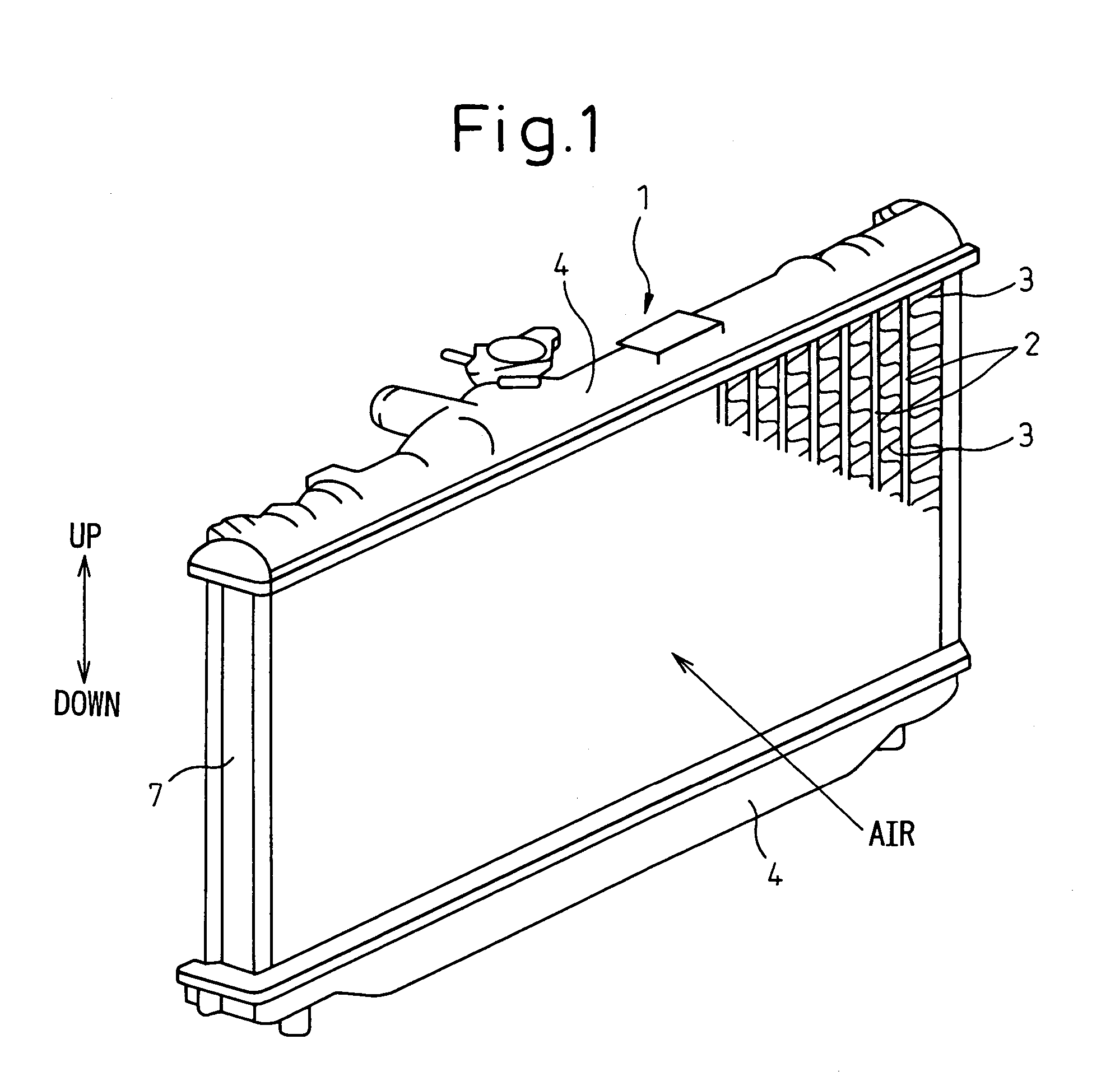Heat exchanger and method of manufacturing core plate
a technology of heat exchanger and core plate, which is applied in the direction of heat exchanger types, indirect heat exchangers, light and heating apparatus, etc., can solve the problem of inability to ensure a sufficiently high mechanical strength, and achieve the effect of preventing deterioration of the manufacturing yield of the core plate and reducing the stress
- Summary
- Abstract
- Description
- Claims
- Application Information
AI Technical Summary
Benefits of technology
Problems solved by technology
Method used
Image
Examples
first embodiment
[0038](First Embodiment)
[0039]In this embodiment, a heat exchanger of the present invention is applied to a radiator for cooling an engine (internal combustion engine) which is a power source to move a vehicle. FIG. 1 is a perspective view of the radiator 1 of the embodiment, FIG. 2 is a sectional view of the header tank, FIG. 3A is a plan view of the core plate, FIG. 3B is a side view of the core plate, FIG. 4 is a perspective view of the core plate, FIG. 5 is a perspective sectional view of the core plate, and FIGS. 6A and 6b are sectional views of the core plate.
[0040]In FIG. 1, the tube 2 is a flat pipe in which cooling water flows. In this embodiment, the longitudinal direction of the tube 2 coincides with the vertical direction, and the sectional profile of the tube 2 is formed so that the major axis direction can coincide with the air flowing direction. In this connection, the direction of the minor axis of the tube 2 is substantially perpendicular to the air flowing directio...
second embodiment
[0057](Second Embodiment)
[0058]In the core plate 5 relating to the first embodiment, in the circumference of the hole 5c which is formed into a flat shape, only the circumference on the minor axis direction side of the hole 5c is inclined with respect to the inserting direction of the tube 2. However, in this embodiment, as shown in FIG. 8, the entire circumference of the hole 5c is inclined with respect to the inserting direction of the tube 2.
[0059]Due to the foregoing, the oblique face in the entire circumference of the hole 5c, that is, the oblique face 5d on the minor axis direction side of the hole 5c and the oblique face 5e on the major axis direction side of the hole 5c function as a guide face in the case of inserting the tube 2 into the hole 5c.
[0060]Accordingly, the working property can be enhanced in the case where the tubes 2 are inserted and incorporated into the core plate 5.
third embodiment
[0061](Third Embodiment)
[0062]This embodiment relates to size in the case of obtaining the work limit in the case of forming the core plate 5 into a wave-shape and also obtaining the necessary mechanical strength.
[0063]Specifically, a ratio (Lp / H) of the wave length size (Lp) of the wave-shaped portion 5b to the difference of elevation (H) of the wave-shaped portion 5b is not less than 0.459 and not more than 0.513.
[0064]In this connection, in this embodiment, the core plate 5 is made of aluminum alloy (JIS (Japanese Industry Standard) A3017), and the thickness t is approximately 1.5 mm.
[0065]In this connection, in this embodiment, Lp is 8.2 mm, H1 is 3.9 mm, and H2 is 6.1 mm in FIG. 9.
PUM
| Property | Measurement | Unit |
|---|---|---|
| thickness | aaaaa | aaaaa |
| temperature | aaaaa | aaaaa |
| thickness | aaaaa | aaaaa |
Abstract
Description
Claims
Application Information
 Login to View More
Login to View More - R&D
- Intellectual Property
- Life Sciences
- Materials
- Tech Scout
- Unparalleled Data Quality
- Higher Quality Content
- 60% Fewer Hallucinations
Browse by: Latest US Patents, China's latest patents, Technical Efficacy Thesaurus, Application Domain, Technology Topic, Popular Technical Reports.
© 2025 PatSnap. All rights reserved.Legal|Privacy policy|Modern Slavery Act Transparency Statement|Sitemap|About US| Contact US: help@patsnap.com



